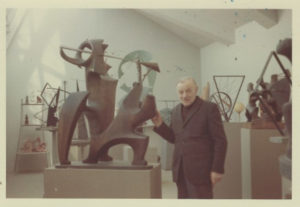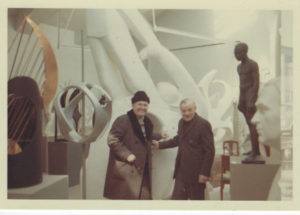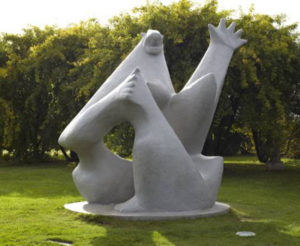The Happy Hollisters and the Mystery of the Man in the Photograph
A modern solution to an old mystery
“Yikes! Will it ever stop raining?” freckle-faced Ricky Hollister muttered.
He was tired of being cooped up inside. “I’m bored!”
“We all are, but I’m sure we can find something fun to do,” his cheerful
blonde sister Pam put in.
“You can help me organize some things I found in the attic,” Mrs. Hollister
offered.
“That sounds fun, Mother,” Pam volunteered. “How can we help?”
“Here’s a box of photos from Daddy’s toy-shopping trips all over the world.
You can start by figuring out where and when they were taken.”
Pete, a strong lad with a crewcut, carried the box to the kitchen table. Pam
carefully removed several bright yellow Kodak envelopes and gave one to each
of her siblings.
“This one says ‘Iceland,’” Holly said as she looked at her envelope.
“Brrr,” little Sue exclaimed. “It must be very cold in Iceyland.” Sue Hollister
was four and always made her family laugh with the funny things she said.
“It’s not always cold in Iceland,” Pete explained. “We learned about the
climate in our geography lesson. It’s a glacial island, but it’s also volcanic, so
they call it the ‘land of fire and ice.’”
Holly held up two photos while she twirled one of her long pigtails. “Who is
this man with Daddy? He looks like a nice man.” The photos showed their
father, wearing a heavy coat and hat, standing with an older gentleman next to
a large sculpture.


“I don’t recognize him. Is there anything written on the back of the photo?”
Holly turned it over. “Nothing really. There’s a date printed on it, but it’s
very small.”
“This is keen! I’ll get my magnifying glass!” Ricky exclaimed and ran to his
room. When he returned, the children crowded around to look through the
glass.
“April 1968. Does that sound right, Mommy?”
“Yes, that’s about when Daddy heard about those troll dolls that were so
popular. Remember, Sue? He brought you a little baby troll doll with neon pink
hair. Trolls are an important part of Icelandic folklore.”
“Let’s call The Trading Post and ask Daddy who this man is,” Holly
suggested.
“I think you’d better not. Daddy said he had a very busy day planned at
work today. Why don’t you see if you can solve the mystery yourselves?” Mrs.
Hollister suggested. “You can use my computer.”
“Swell! We can look some things up on the internet. The way the man is
standing next to the sculpture, I’ll bet he’s the artist. He looks very proud of
that piece,” Pete observed.
Pam fired up her mother’s laptop and moments later had printed a list of
Icelandic sculptors. “It’s kind of a long list. How will we ever figure out if he’s
one of them?”
Mrs. Hollister glanced at the list. “I remember Daddy saying that Icelandic
names are patronymic. That will help.”
“Patro-what?? And how will that help?” Ricky queried.
“It means you can tell who someone’s father was by their name. You know
that author you like so much—Andrew Svenson? His last name means ‘son of
Sven.’ And the name Svensdottir would mean ‘daughter of Sven.’”
“Oh, how interesting,” Pam added. “So if there are any names of sculptors
that end in -dottir, we can cross them off because they are women.”
“Good thinking, Pam!” Pete said excitedly as he crossed some names off the
list. “That leaves us with just ten names. Maybe next we could figure out when
each artist was born.”
“Right,” Pam agreed. “This man looks like he’s about 70 years old. If the
picture was taken in 1968, that means he would have been born around 1898.”
“Crickets!” Ricky shouted. “That’s like ancient history!”
“Ricky, get my laptop, and we can divvy up the list of names,” Pete
suggested. “You, Holly, and Sue can look up the first five names on the list,
and we’ll take the last five.”
Mrs. Hollister smiled as the kitchen fell silent and her family of sleuths went
to work. Occasionally she heard bursts of “Nope—too young” or “Rats! This
one’s too old.”
Suddenly, Pam called out, “I think I found him. I don’t know how to
pronounce his name, but this one—Ásmundur Sveinsson—was born in 1893.
That’s pretty close.”
Pam pointed to a very small photo of the sculptor on her screen.
“Gee, sis, you might be right,” Pete concurred, “but it’s hard to tell for sure if
he’s the same person in Daddy’s picture. Now what?”
The children sat quietly and pondered their dilemma. Suddenly, Pete
snapped his fingers. “I know how we can find out! Let’s send an email to a
museum in Iceland and ask if they recognize the man.”
With a few quick taps on the computer, Holly had found the email address
for the director of the Reykjavik Art Museum, and Ricky scanned the old
photographs. Pam wrote a quick email to the director asking for help and ping!
the email was sent.
“Daddy will be so s’prised if we find out who this is before he gets home
from work,” Sue said excitedly.
“We won’t get an answer back right away, Susie,” Pam explained. “It could
take a while. Let’s not say anything to Daddy until we find out more.”
Fortunately Mr. Hollister worked late that evening and didn’t return home
until after the children had gone to bed, so it was easy for them to keep their secret.
The next morning after breakfast, Ricky handed their father his briefcase,
and Holly plopped his hat on his head. “You’d better hurry, Daddy, so you’re
not late for work.”
“If I didn’t know better, I’d think you children were up to something,” Mr.
Hollister smiled as he headed out the door. “I can take a hint.”
As soon as Mr. Hollister’s car pulled out of the driveway, Pam hurried over
to the computer to check her email.
“We got a response from someone named Edda!” she said, her face flushed
with excitement.
“What does he say?” Ricky shouted, and the children huddled around the
computer.
“Pam silently read a few lines of the email and then smiled. “Edda is a she—I
know that because her name ends in -dottir—and she’s attached another
photo!” Pam read the email out loud, which said:
The man in the pictures is indeed sculptor Ásmundur Sveinsson,
standing in his home and studio in Sigtún, Reykjavík. Ásmundur
was a very prominent figure in Icelandic cultural life and is one of
the most beloved Icelandic sculptors. His outdoor sculptures are to
be found all over the city and also out in the countryside and are a
part of people‘s everyday life. Children love to play in them. After his
death, Ásmundur bequeathed his works and his home/studio to the
city of Reykjavík and is since 1983 one of Reykjavík Art Museum‘s
three locations. It is also an interesting fact that one of Ásmundur
Sveinsson‘s largest and most striking outdoor sculptures,
standing in the sculpture garden in front of his house (now museum) is
Tröllkonan, the Troll Woman from 1946.

“Yowza! I always wondered why Daddy bought so many of those troll dolls
to sell at The Trading Post!” Pete exclaimed. “This explains it! We solved the
mystery! Three cheers for Ásmundur Sveinsson and his Troll Woman!”
The children exchanged high fives all around, and Mrs. Hollister started
making a batch of chocolate chip cookies to celebrate their success.
Suddenly, little Sue made a sad face. “I wish we hadn’t rushed Daddy out
the door so fast. Now we can’t ask him to take us to Iceland to play with the
troll woman.”
NOTE: As you may have noticed, one of the men in the photographs is
actually Happy Hollisters author Andrew Svenson (Jerry West), and we’ve
combined him with the fictional character of John Hollister to create this story.
The rest of the story is true, however. We were very curious about two
unidentified photographs that were found recently at the home of Svenson’s
eldest daughter, Laura. Thanks to some modern internet sleuthing and the
gracious assistance of Edda Halldórsdóttir and Steinunn Hauksdóttir of the
Reykjavik Art Museum, we were able to identify Ásmundur Sveinsson as the
man in these pictures.
Although we don’t know the backstory of how the two men came to meet,
Ásmundur evidently made an impression on Andrew Svenson, enough to use
his name for a character in the book. We had always assumed that “Sveinsson”
was simply an Icelandic-language alternative for “Svenson,” but now we know
this character was inspired by a real person. Learning that one of Ásmundur
Sveinsson’s most famous sculptures is called “Troll Woman,” it’s fun to imagine
how a conversation about the sculpture could lead to a discussion of Icelandic
folkore and from there to The Happy Hollisters and the Mystery of the Midnight
Trolls.
In the story, Karl Sveinsson is an Icelandic sailplane enthusiast, much like
John Hollister, and the two men are working together to perfect Mr. Hollister’s
entry for the international sailplane convention to be held in Iceland. The
Hollisters are invited to stay with the man and his family on their farm outside
of Reykjavik. His daughter Helga is blind, and she teaches the Hollisters to use
braille as a secret code; before long, the children are all working together to
find an ancient treasure. A trio of “trolls” tries to thwart their attempts to find
the treasure, but they persevere, enjoying exciting adventures on horseback
across the lava-strewn countryside. They also learn about the geography and
history of Iceland as they foray into Thingvellir National Park, archaeological
site of the Althing, the national parliament of Iceland which was first held in
the year 930.
The Happy Hollisters and the Mystery of the Midnight Trolls was originally
published in 1970, the 33rd and final book in the series. The Happy Hollisters
series went out of print in 1971, and Midnight Trolls became one of the most
difficult hardcover books for Happy Hollister collectors and fans to find. If
you’re interested in “seeing” Iceland through the Hollisters’ adventures—and
solving a swell mystery, this book has now been reissued in paperback and
digital formats.
To see more of Asmundur Sveinsson’s sculptures, visit
https://artmuseum.is/asmundarsafn

